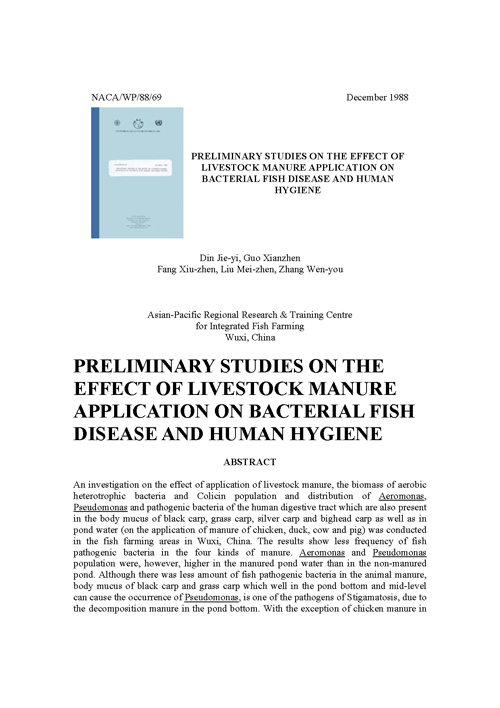Preliminary studies on the effect of livestock manure application on bacterial fish disease and human hygiene
1 December 1998 | Din Jie-yi, Guo Xianzhen, Fang Xiu-zhen, Liu Mei-zhen and Zhang Wen-you | 937 Downloads | .pdf | 188.68 KB | Food Security, Safety and Certification, Freshwater finfish, Health and Biosecurity, Inland aquaculture
An investigation on the effect of application of livestock manure, the biomass of aerobic heterotrophic bacteria and Colicin population and distribution of Aeromonas, Pseudomonas and pathogenic bacteria of the human digestive tract which are also present in the body mucus of black carp, grass carp, silver carp and bighead carp as well as in pond water (on the application of manure of chicken, duck, cow and pig) was conducted in the fish farming areas in Wuxi, China.
The results show less frequency of fish pathogenic bacteria in the four kinds of manure. Aeromonas and Pseudomonas population were, however, higher in the manured pond water than in the non-manured pond. Although there was less amount of fish pathogenic bacteria in the animal manure, body mucus of black carp and grass carp which well in the pond bottom and mid-level can cause the occurrence of Pseudomonas, is one of the pathogens of Stigamatosis, due to the decomposition manure in the pond bottom. With the exception of chicken manure in which there was Group E Salmonella, no other pathogenic bacteria was found in the manure of duck, cow and pig. None was found either on the fish body nor in the fish viscera in the manure-applied fish pond. Bacteria were pathogenic.
The fish cultured in the manure-applied pond were descaled and washed, the quantity of Colicin was reduced by 100-1000 times, the concentration of which was almost the same as that in the manure-free pond. MPN was less or equal to 40***(*** MPN.--- The most Probable number of Colicin within sq. sm of fish body. Results indicated that the fish cultured in manure-applied ponds after treatment by washing are hygienic as human food and not harmful to human health.
Creative Commons Attribution.

